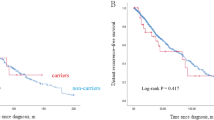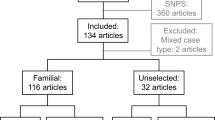Abstract
Recent reports have shown that mutations in the FANCJ/BRIP1 and FANCN/PALB2 Fanconi Anemia (FA) genes confer a moderate breast cancer risk. Discussion has been raised on the phenotypic characteristics of the PALB2-associated families and tumors. The role of FANCB in breast cancer susceptibility has not been tested to date. Likewise PALB2 mutation frequency has not been studied in Spanish population. We analyzed the complete coding sequence and splicing sites of FANCB and PALB2 in 95 index cases of BRCA1/2-negative Spanish breast cancer families. We also performed an exhaustive screening of three previously described rare but recurrent PALB2 mutations in 725 additional probands. Pathogenic changes were not detected in FANCB. We found a novel PALB2 truncating mutation c.1056_1057delGA (p.K353IfsX7) in one of the 95 screened patients, accounting for a mutation frequency of 1% in our series. Further comprehensive screening of the novel mutation and of previously reported rare but recurrent PALB2 mutations did not reveal any carrier patient. We report the first example of LOH occurring in a PALB2-associated tumor. Our results rule out a major contribution of FANCB to hereditary breast cancer. Our data are consistent with the notion of individually rare PALB2 mutations, lack of mutational hot-spots in the gene and existence of between-population disease-allele heterogeneity. We show evidence that PALB2 loss of function might also conform to the inactivation model of a classic tumor-suppressor gene and present data that adds to the clinically relevant discussion about the existence of a PALB2-breast cancer phenotype.


Similar content being viewed by others
References
Joenje H, Patel KJ (2001) The emerging genetic and molecular basis of Fanconi anaemia. Nat Rev Genet 2:446–457
Smogorzewska A, Matsuoka S, Vinciguerra P et al (2007) Identification of the FANCI protein, a monoubiquitinated FANCD2 paralog required for DNA repair. Cell 129:289–301
Mathew CG (2006) Fanconi anaemia genes and susceptibility to cancer. Oncogene 25:5875–5884
Whitney MA, Saito H, Jakobs PM et al (1993) A common mutation in the FACC gene causes Fanconi anaemia in Ashkenazi Jews. Nat Genet 4:202–205
Callen E, Casado JA, Tischkowitz MD et al (2005) A common founder mutation in FANCA underlies the world’s highest prevalence of Fanconi anemia in Gypsy families from Spain. Blood 105:1946–1949
Wang W (2007) Emergence of a DNA-damage response network consisting of Fanconi anaemia and BRCA proteins. Nat Rev Genet 8:735–748
Howlett NG, Taniguchi T, Olson S et al (2002) Biallelic inactivation of BRCA2 in Fanconi anemia. Science 297:606–609
Seal S, Barfoot R, Jayatilake H et al (2003) Evaluation of Fanconi Anemia genes in familial breast cancer predisposition. Cancer Res 63:8596–8599
Luo L, Lei H, Du Q et al (2002) No mutations in the BACH1 gene in BRCA1 and BRCA2 negative breast-cancer families linked to 17q22. Int J Cancer 98:638–639
Karppinen SM, Vuosku J, Heikkinen K et al (2003) No evidence of involvement of germline BACH1 mutations in Finnish breast and ovarian cancer families. Eur J Cancer 39:366–371
Vahteristo P, Yliannala K, Tamminen A et al (2006) BACH1 Ser919Pro variant and breast cancer risk. BMC Cancer 6:19
Lewis AG, Flanagan J, Marsh A et al (2005) Mutation analysis of FANCD2, BRIP1/BACH1, LMO4 and SFN in familial breast cancer. Breast Cancer Res 7:R1005–1016
Seal S, Thompson D, Renwick A et al (2006) Truncating mutations in the Fanconi anemia J gene BRIP1 are low-penetrance breast cancer susceptibility alleles. Nat Genet 38:1239–1241
Xia B, Dorsman JC, Ameziane N et al (2007) Fanconi anemia is associated with a defect in the BRCA2 partner PALB2. Nat Genet 39:159–161
Reid S, Schindler D, Hanenberg H et al (2007) Biallelic mutations in PALB2 cause Fanconi anemia subtype FA-N and predispose to childhood cancer. Nat Genet 39:162–164
Rahman N, Seal S, Thompson D et al (2007) PALB2, which encodes a BRCA2-interacting protein, is a breast cancer susceptibility gene. Nat Genet 39:165–167
Tischkowitz M, Xia B, Sabbaghian N et al (2007) Analysis of PALB2/FANCN-associated breast cancer families. Proc Natl Acad Sci USA 104:6788–6793
Erkko H, Xia B, Nikkila J et al (2007) A recurrent mutation in PALB2 in Finnish cancer families. Nature 446:316–319
Foulkes WD, Ghadirian P, Akbari MR et al (2007) Identification of a novel truncating PALB2 mutation and analysis of its contribution to early-onset breast cancer in French-Canadian women. Breast Cancer Res. doi:10.1186/bcr1828. (in press)
Milne RL, Ribas G, Gonzalez-Neira A et al (2006) ERCC4 associated with breast cancer risk: a two-stage case-control study using high-throughput genotyping. Cancer Res 66:9420–9427
Llort G, Munoz CY, Tuser MP et al (2002) Low frequency of recurrent BRCA1 and BRCA2 mutations in Spain. Hum Mutat 19:307
Diez O, Osorio A, Duran M et al (2003) Analysis of BRCA1 and BRCA2 genes in Spanish breast/ovarian cancer patients: a high proportion of mutations unique to Spain and evidence of founder effects. Hum Mutat 22:301–312
Osorio A, Barroso A, Martinez B et al (2000) Molecular analysis of the BRCA1 and BRCA2 genes in 32 breast and/or ovarian cancer Spanish families. Br J Cancer 82:1266–1270
de la Hoya M, Perez-Segura P, Van Orsouw N et al (2001) Spanish family study on hereditary breast and/or ovarian cancer: analysis of the BRCA1 gene. Int J Cancer 91:137–140
Beristain E, Martinez-Bouzas C, Guerra I et al (2007) Differences in the frequency and distribution of BRCA1 and BRCA2 mutations in breast/ovarian cancer cases from the Basque country with respect to the Spanish population: implications for genetic counselling. Breast Cancer Res Treat 106:255–262
den Dunnen JT, Paalman MH (2003) Standardizing mutation nomenclature: why bother? Hum Mutat 22:181–182
den Dunnen JT, Antonarakis SE (2000) Mutation nomenclature extensions and suggestions to describe complex mutations: a discussion. Hum Mutat 15:7–12
Rahman N, Scott RH (2007) Cancer genes associated with phenotypes in monoallelic and biallelic mutation carriers: new lessons from old players. Hum Mol Genet 16 Spec No 1:R60–R66
Berwick M, Satagopan JM, Ben-Porat L et al (2007) Genetic heterogeneity among Fanconi anemia heterozygotes and risk of cancer. Cancer Res 67:9591–9596
Acknowledgements
We are grateful to Prof. Nazneen Rahman for kindly providing us with DNA samples from carriers of the previously described c.3113G>A, c.3116delA and c.3549C>G PALB2 mutations used as positive controls in our screening; G. Ribas for valuable advise on DHPLC conditions and for helpful discussions; O. Díez and M. Baiget (Department of Genetics, La Santa Creu i Sant Pau Hospital) for their contribution in the ascertainment of part of the families included in the study; S.M. Rodríguez-Pinilla and M. Cañamero for histopathological revision of the PALB2 tumor and definition of areas for further macrodisecction; R.L. Milne for biostatistical support; S. Carilla for his contribution to this project; F. Fernández, C. Alonso and L. Moreno for excellent technical assistance. M.J. García is supported by the Centro de Investigación Biomédica en Red de Enfermedades Raras (CIBERER), Instituto de Salud Carlos III, Spain. This work was partially supported by the Fancogene Project (Fundación Genoma España) Pharmamar and the Spanish Network of Cancer (Grant RTICC 06/0020/0021).
Author information
Authors and Affiliations
Corresponding author
Electronic supplementary material
Below is the link to the electronic supplementary material.
Rights and permissions
About this article
Cite this article
García, M.J., Fernández, V., Osorio, A. et al. Analysis of FANCB and FANCN/PALB2 Fanconi Anemia genes in BRCA1/2-negative Spanish breast cancer families. Breast Cancer Res Treat 113, 545–551 (2009). https://doi.org/10.1007/s10549-008-9945-0
Received:
Accepted:
Published:
Issue Date:
DOI: https://doi.org/10.1007/s10549-008-9945-0




